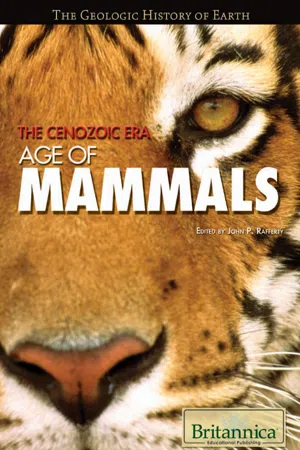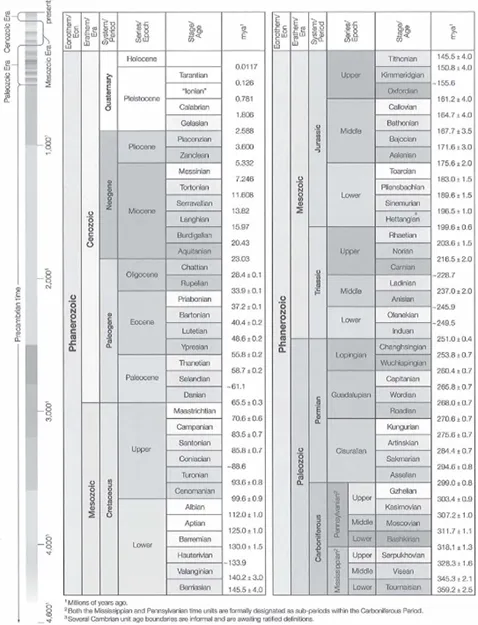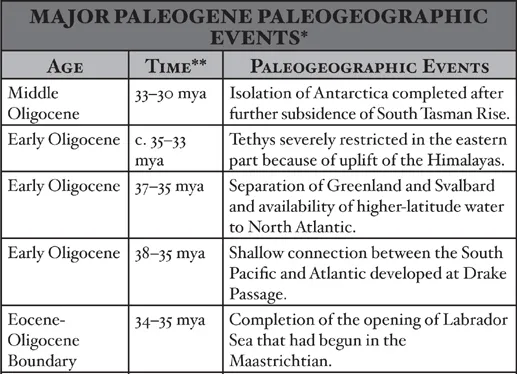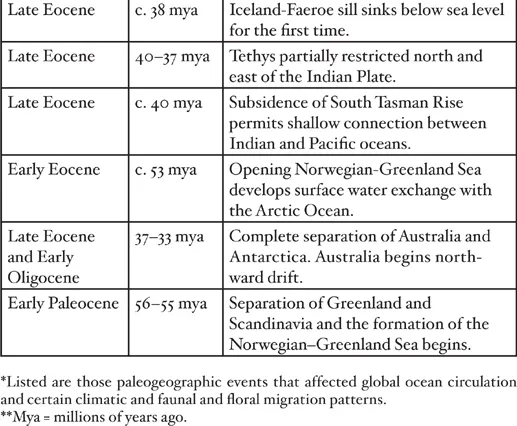
This is a test
- English
- ePUB (mobile friendly)
- Available on iOS & Android
eBook - ePub
Book details
Book preview
Table of contents
Citations
About This Book
Its constant evolution over the millennia since its inception has made the Earth a dynamic entity, subject to numerous climactic and environmental forces that are forever changing this planet. In its most recent stage, the planet has seen an incredible diversification in plant and animal life, with the most prominent development of the Cenozoic era being the emergence of mammals. This book examines our most immediate ancestors and the geologic, geographic, and environmental factors that helped make their primacy inevitable.
Frequently asked questions
At the moment all of our mobile-responsive ePub books are available to download via the app. Most of our PDFs are also available to download and we're working on making the final remaining ones downloadable now. Learn more here.
Both plans give you full access to the library and all of Perlego’s features. The only differences are the price and subscription period: With the annual plan you’ll save around 30% compared to 12 months on the monthly plan.
We are an online textbook subscription service, where you can get access to an entire online library for less than the price of a single book per month. With over 1 million books across 1000+ topics, we’ve got you covered! Learn more here.
Look out for the read-aloud symbol on your next book to see if you can listen to it. The read-aloud tool reads text aloud for you, highlighting the text as it is being read. You can pause it, speed it up and slow it down. Learn more here.
Yes, you can access The Cenozoic Era by Britannica Educational Publishing, John P Rafferty in PDF and/or ePUB format, as well as other popular books in Physical Sciences & Geology & Earth Sciences. We have over one million books available in our catalogue for you to explore.
Information
Topic
Physical SciencesSubtopic
Geology & Earth SciencesCHAPTER 1
AN OVERVIEW OF CENOZOIC TIME
The Cenozoic is the youngest and most recent of Earth’s geologic eras. Emerging from a time of mass extinction, Cenozoic animals diversified, filling the empty niches previously occupied by the dinosaurs. The era was characterized by the radiation of mammals, the proliferation of grasses across the planet, and the migration of continents to their present location. The Cenozoic was also known as the time in which the Indian subcontinent crashed into southern Asia, forming the Himalayas, and land bridges connecting the continents rose and fell with changing climatic conditions and tectonic activity.
Near the end of the era, great ice sheets expanded and contracted over the northern continents. Antarctica, a landmass once lush with vegetation and a rich diversity of animal life, froze over shortly after its exile at the bottom of the world. The Cenozoic Era was the setting in which the primates arose. Some groups of primates remained quadrupedal and arboreal, whereas others developed bipedal locomotion and engaged in tool use. The most notable of the latter type was the genus Homo, whose members created increasingly sophisticated tools that they used to dominate the Earth.
The term Cenozoic, originally spelled Kainozoic, was introduced by John Phillips in an 1840 Penny Cyclopaedia article to designate the most recent of the three major subdivisions of the Phanerozoic. Derived from the Greek for “recent life,” it reflects the sequential development and diversification of life on Earth from the Paleozoic (ancient life) through the Mesozoic (middle life). Today, the Cenozoic is internationally accepted as the youngest of the three subdivisions of the fossiliferous part of Earth history.
GEOLOGIC TIME SCALE

Encyclopædia Britannica, Inc. Source: International Commission on Stratigraphy (ICS)

The Cenozoic Era is generally divided into the Paleogene (65.5 million to 23 million years ago), Neogene (23 million to 2.6 million years ago), and Quaternary (2.6 million years ago to the present) periods, the era’s traditional division is into the Tertiary and Quaternary periods. The designations Tertiary and Quaternary, however, are relics of early attempts in the late 18th century at formulating a stratigraphic classification that included the now wholly obsolete terms Primary and Secondary. In 1856 Moritz Hörnes introduced the terms Paleogene and Neogene, the latter encompassing rocks equivalent to those described by Charles Lyell as Miocene and older and newer Pliocene (including what he later called the Pleistocene). Subsequent investigators have determined that the designation Neogene correctly applies to the rock systems and corresponding time intervals delineated by Lyell, but some authorities prefer to exclude the Pleistocene from the Neogene. The Paleogene encompasses the Paleocene, Eocene, and Oligocene epochs. (The terms Paleocene and Oligocene were coined subsequent to Lyell’s work and inserted in the lower part of the Cenozoic stratigraphic scheme.) The Neogene spans the Miocene and Pliocene epochs, and the Quaternary includes the Pleistocene and Holocene epochs.
GEOLOGIC PROCESSES
Cenozoic rocks are extensively developed on all the continents, particularly on lowland plains, such as the Gulf and Atlantic coastal plains of North America. They are generally less consolidated than older rocks, but some are indurated (cemented) as a result of high pressure caused by deep burial, chemical diagenesis, or high temperature—namely, metamorphism. Sedimentary rocks predominate during the Cenozoic, and more than half the world’s petroleum occurs in such rocks of this age. Igneous rocks are represented by extensive early Cenozoic flood basalts (those of East Greenland and the Deccan trap of India) and the late Cenozoic flood basalts of the Columbia River in Washington, as well as by numerous volcanoes in the circum-Pacific System and ocean island chains such as Hawaii.

Medial moraine of Gornergletscher (Gorner Glacier) in the Pennine Alps near Zermatt, Switz. Jerome Wyckoff
Several of the world’s great mountain ranges were built during the Cenozoic. The main Alpine orogeny, which produced the Alps and Carpathians in southern Europe and the Atlas Mountains in northwestern Africa, began roughly between 37 and 24 million years ago. The Himalayas were formed some time after the Indian Plate collided with the Eurasian Plate. These lofty mountains marked the culmination of the great uplift that occurred during the late Cenozoic when the Indian Plate drove many hundreds of kilometres into the underbelly of Asia. They are the product of the low-angle underthrusting of the northern edge of the Indian Plate under the southern edge of the Eurasian Plate.
From about five million years ago, the Rocky Mountains and adjoining areas were elevated by rapid uplift of the entire region without faulting. This upwarping sharply steepened stream gradients, enabling rivers to achieve greater erosional power. As a result, deep river valleys and canyons, such as the Grand Canyon, of the Colorado River in northern Arizona, were cut into broad upwarps of sedimentary rock during late Cenozoic time.
On a global scale the Cenozoic witnessed the further dismemberment of the Northern Hemispheric supercontinent of Laurasia: Greenland and Scandinavia separated during the early Cenozoic about 55 million years ago and the Norwegian-Greenland Sea emerged, linking the North Atlantic and Arctic oceans. The Atlantic continued to expand while the Pacific experienced a net reduction in size as a result of continued seafloor spreading. The equatorially situated east–west Tethyan seaway linking the Atlantic and Pacific oceans was modified significantly in the east during the middle Eocene (about 45 million years ago) by the junction of India with Eurasia, and it was severed into two parts by the confluence of Africa, Arabia, and Eurasia during the early Miocene approximately 18 million years ago. The western part of the Tethys evolved into the Mediterranean Sea not long after it had been cut off from the global ocean system about 6 to 5 million years ago and had formed evaporite deposits which reach up to several kilometres in thickness in a land-locked basin that may have resembled Death Valley in present-day California. Antarctica remained centred on the South Pole throughout the Cenozoic, but the northern continents converged in a northward direction.
The global climate was much warmer during the early Cenozoic than it is today, and equatorial-to-polar thermal gradients were less than half of what they are at present. The Earth began to cool about 50 million years ago and, with fluctuations of varying amounts, has continued inexorably to the present interglacial climatic period. It is to be noted that a unique feature of the Cenozoic was the development of glaciation on the Antarctic continent about 35 million years ago and in the Northern Hemisphere between 3 and 2.5 million years ago. Glaciation left an extensive geologic record on the continents in the form of predominantly unconsolidated tills and glacial moraines, which in North America extend in a line as far south as Kansas, Illinois, Ohio, and Long Island, N.Y., and on the ocean floor in the form of ice-rafted detritus dropped from calving icebergs.
CENOZOIC LIFE
Cenozoic life was strikingly different from that of the Mesozoic. The great diversity that characterizes modern-day flora is attributed to the explosive expansion and adaptive radiation of the angiosperms that began during the Late Cretaceous. As climatic differentiation increased over the course of the Cenozoic, flora became more and more provincial. Deciduous angiosperms predominated in colder regions, for example, whereas evergreen varieties prevailed in the subtropics and tropics.
Fauna also underwent dramatic changes during the Cenozoic. The end of the Cretaceous brought the eradication of dinosaurs on land and of large swimming reptiles (such as ichthyosaurs, mosasaurs, and plesiosaurs) in marine environments. Nektonic ammonites, squidlike belemnites, sessile reef-building mollusks known as rudistids, and most microscopic plankton also died out at this time. The Cenozoic witnessed a rapid diversification of life-forms in the ecological niches left vacant by this great terminal Cretaceous extinction. In particular, mammals, having existed for more than 100 million years before the advent of the Cenozoic Era, experienced substantial evolutionary radiation. Marsupials developed a diverse array of adaptive types in Australia and South America, where they were free from the predations of carnivorous placentals. The placental mammals, which today make up more than 95 percent of known mammals, radiated at a rapid rate. Ungulates (hoofed mammals) with clawed feet evolved during the Paleocene (65.5 to about 55.8 million years ago). This epoch saw the development and proliferation of the earliest perissodactyls (odd-toed ungulates, such as horses, tapirs, rhinoceroses, and two extinct groups, the chalicotheres and titanotheres) and artiodactyls (even-toed ungulates, including pigs, peccaries, hippopotamuses, camels, llamas, chevrotains, deer, giraffes, sheep, goats, musk-oxen, antelopes, and cattle). During the later Cenozoic, perissodactyl diversity declined markedly, but artiodactyls continued to diversify. Elephants, which evolved in the late Eocene about 40 million years ago, spread throughout much of the world and underwent tremendous diversification at this time. Many placental forms of giant size, such as the sabre-toothed cat, giant ground sloths, and woolly mammoths, inhabited the forests and the plains in the Pliocene (5.3 to 1.8 million years ago). About this time the first hominids appeared, but early modern humans did not emerge until the Pleistocene.
Among marine life-forms, mollusks (primarily pelecypods and gastropods) became highly diversified, as did reef-building corals characteristic of the tropical belt. Planktonic foraminiferans underwent two major radiations (the first in the Paleocene and the second in the Miocene) punctuated by a long (15- to 20-million-year) mid-Cenozoic reduction in diversity related in all likelihood to global cooling.
Cenozoic life was affected significantly by a major extinction event that occurred between 10,000 and 8,000 years ago. This event, which involved the sudden disappearance of many Ice Age mammals, has been attributed to either of two factors: climatic change following the melting of the most recent Pleistocene glaciers or overkill by Paleolithic hunters. The latter is regarded by many as the more likely cause, as the rapidly improved technology of Paleolithic humans permitted more efficient hunting.
CHAPTER 2
THE TERTIARY PERIOD
The Tertiary Period is an unofficial interval of geologic time lasting from approximately 65.5 million to 2.6 million years ago. It is the traditional name for the first of two periods in the Cenozoic Era (65.5 million years ago to the present). The second is the Quaternary Period (2.6 million years ago to the present). The five principal subdivisions of the Tertiary are called epochs, which from oldest to youngest are the Paleocene (65.5–55.8 million years ago), Eocene (55.8–33.9 million years ago), Oligocene (33.9–23 million years ago), Miocene (23–5.3 million years ago), and Pliocene (5.3–2.6 million years ago). Beginning in the late 20th century, many authorities preferred not to use the terms Tertiary and Quaternary, opting instead to divide the time intervals encompassed by each into two different intervals known as the Paleogene Period (65.5–23 million years ago) and the Neogene Period (which previously spanned the interval between 23 million years ago and the present). In 2005 the International Commission on Stratigraphy (ICS) decided to recommend keeping the Tertiary and Quaternary in their geologic time scale, but only as sub-eras within the Cenozoic. The sub-era structure was abandoned by the ICS in 2008, and the Tertiary Period became officially replaced by the Paleogene and Neogene periods. (At present, the Neogene encompasses the interval between 23 million and 2.6 million years ago.)
The Tertiary was an interval of enormous geologic, climatic, oceanographic, and biological change. It spanned the transition from a globally warm world containing relatively high sea levels and dominated by reptiles to a world of polar glaciation, sharply differentiated climate zones, and mammalian dominance. It began in the aftermath of the mass extinction event that occurred at the very end of the Cretaceous Period (the so-called K–T boundary), when as much as 80 percent of species, including the dinosaurs, disappeared. The Tertiary witnessed the dramatic evolutionary expansion of mammals as well as of flowering plants, insects, birds, corals, deep-sea organisms, marine plankton, and mollusks (especially clams and snails), among many other groups. The Tertiary Period saw huge alterations in Earth’s systems and the development of the ecological and climatic conditions that characterize the modern world. The end of the Tertiary is characterized by the growth of glaciers in the Northern Hemisphere and the emergence of primates that later gave rise to modern humans (Homo sapiens), chimpanzees (Pan troglodytes), and other living great apes.
The name Tertiary was introduced by Italian geologist Giovanni Arduino in 1760. Arduino devised a stratigraphic system in which sedimentary rocks containing fossils were called “tertiary” rocks to distinguish them from igneous and metamorphic rocks present in the cores of mountain ranges (“primary” rocks), the shales and limestones of Europe (“secondary” rocks), and surficial gravel (“quaternary” rocks). Although by modern standards his system appears simplistic, it provides the initial framework on which modern stratigraphy is based.
THE TERTIARY ENVIRONMENT
The configuration of continents and oceans at the beginning of Tertiary times bore some resemblance to that of the present day. At the beginning of the period, the relative positions of North and South America, Europe, Asia, and Africa approximated those of modern times, but all were separated from one another by large seaways. This ocean-continent geometry diverted ocean currents, which were important factors in determining regional climate. Tectonic forces eventually closed off some of these seaways and opened others, such as the one between Australia and Antarctica. Land bridges, such as the one connecting North and South America, redirected ocean currents and allowed plants and animals to migrate into new areas.
PALEOGEOGRAPHY
The present-day configuration of the continents and oceans on Earth is the result of a complex sequence of events involving the growth and rearrangement of Earth’s tectonic plates that began almost 200 million years ago. By the beginning of the Tertiary, the supercontinent of Pangea had been fragmenting for more than 100 million years, and the geometry of the continents and oceans had assumed an essentially modern aspect with several notable exceptions. The fragmentation and dispersal of the Southern Hemisphere supercontinent known as Gondwana, which had begun in the early part of the Mesozoic Era (251–65.5 million years ago), continued into the Cenozoic. Australia began to separate from Antarctica about 58 million years ago during the late Paleocene Epoch. The initial subsidence of the South Tasman Rise, which occurred about 35 million years ago during the late Eocene Epoch, resulted in a shallow but inexorably widening oceanic connection between the Indian and Pacific oceans. It was this progressive separation of the two continents that led to the development of the Antarctic Circumpolar Current, a current that sweeps around Antarctica and thermally isolates it from the effects of warmer waters and climates to the north. This current was strengthened further and assumed its modern form as Antarctica and South America separated and thus formed the Drake Passage. There is much debate over when this opening actually occurred. Some experts state that the Drake Passage opened as early as during the Eocene about 41 million years ago, whereas others maintain that this event took place as late as the boundary between the Oligocene and Miocene epochs about 23 million years ago.


The collision of India and southern Asia began during the late Paleocene, approximately 55 million years ago, and continues today. The collision produced two main geologic results. ...
Table of contents
- Cover Page
- Title Page
- Copyright Page
- Contents
- Introduction
- Chapter 1: An Overview of Cenozoic Time
- Chapter 2: The Tertiary Period
- Chapter 3: The Paleogene Period
- Chapter 4: The Neogene Period
- Chapter 5: The Quaternary Period
- Chapter 6: The Pleistocene Epoch
- Chapter 7: The Holocene Epoch
- Chapter 8: The Cenozoic and Beyond
- Glossary
- For Further Reading
- Index